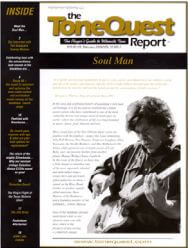
Ten years after our first published amp review (the blackface Vibrolux Reverb), we still find ourselves answering readers’ questions about which amp to buy. We’re not complaining… your subscription to TQR has always included phone or email access for those contemplating a new gear purchase, but it seems that published reviews can still sometimes prompt more questions than answers. We understand, and like you, we are routinely faced with these same buying decisions just about every month as we look ahead to future issues. “Power” and “headroom” (or lack of it) seem to remain among the most daunting considerations for prospective amp buyers. This may not keep you up at night if you’re looking for a toneful box to play solely at home, but the range of clean and overdriven tones available from a single amplifier that can hang with a band is absolutely critical – the tipping point for guitarists who wish to have both clean and grittier tones available on the fly. And even the casual “bedroom” player (does anyone really play their guitars in the bedroom?) will quickly discover that big, lush guitar tones – clean or jacked into rich distortion – are often best obtained through a “bigger” amp. We’re not suggesting that we don’t love our ’58 tweed Tremolux or ’64 Deluxe – they both uniquely, timelessly epitomize great guitar tones – but an entirely different realm exists within the range of vintage Fender amps, and try as we might, we have never found another amplifier quite as versatile, user-friendly or uniquely toneful as the blackface (1965–7) 40 watt Pro Reverb – still the most under-valued and overlooked reverb amp from the entire blackface era, although aside from its 2×12 speaker configuration, the Pro is nearly identical to the Vibrolux and the Super Reverb amps.
Yes, the 2×12 Pro Reverb can move some air, just as an AC30or Matchless DC30, both highly coveted amps for good reason, do the same. Experienced in a room, 2×12 amps produce an ambient presence and a spatial quality that single 12s can’t match. That extra speaker isn’t adding volume as much as it simply disperse sound effectively by filling more space. And although the Pro Reverb is rated at 40 watts, the smaller output transformer Leo Fender chose to use delivers only 28 watts, probably in an effort to minimize speaker failure, yet the original Oxford and Jensen 12 s shipped in the Pro still blew when pushed by enthusiastic rockers. A well-maintained Pro Reverb will typically produce classically clean Fender tones with strong bass and treble and slightly diminished mids from “2” on the volume control to “5,” gradually spilling into lush Fendery distortion at higher settings. If you choose to use an overdrive device to achieve distortion at lower volume levels, the Pro will sound significantly better than most 20 watt amps because your pedal is affecting a cleaner signal, rather than adding distortion to an amp already spilling over into distortion. And as we have reported so often in the past, non-invasive and completely reversible modifications can be made, such as the addition of a 25K mid range pot utilizing the existing back panel hole for the extension speaker jack. This single mod enables the Pro to develop a very ballsy British voice as midrange is increased, while completely preserving the integrity of the original Fullerton tone with the midrange pot set at zero, rendering two outstanding amps in one. Intrigued? You should be, because we have never heard a contemporary boutique 2×12 combo amp that can approach the sound of a Pro Reverb equipped with a solid set of tubes and speakers. And with the range of speaker options available today, you can effectively custom design and shape the sound of your Pro for more of a traditional, bright“American” sound, a heavier or chimier British tone, or the two combined.
Ah, but buying old amps is risky business says you… what if I get a “dog” or it needs a lot of work? I’d rather buy some-thing new and not deal with the unknown. Fine, do that. But for those willing to reap the rewards that only a certain degree of risk can offer, it’s not that difficult to minimize your chances for disappointment. Here’s how: